How to Design and Successfully Run a Referral Program for E-commerce?

If you’ve ever been persuaded to buy a product online because a friend recommended it, you’ve experienced firsthand why ecommerce referral programs are so effective. Consumers frequently seek input from others before making purchasing decisions.
Ecommerce referral programs represent one of the most efficient and economical methods to gather leads and expand your customer base. Research from Nielsen indicates that 88% of customers trust recommendations from friends and family more than any other form of advertising. Social proof plays a significant role in helping individuals understand why they should opt for a particular product or brand over alternatives.
This article delves into the benefits of implementing an ecommerce referral program for your online store, including how it can generate leads and boost sales. Also, get to know pros and cons, best practices and most common tools to facilitate your programs in our guide.
Referral Marketing - Is it Any Different from Affiliate Marketing?
Referral marketing is any promotional endeavor that encourages your past and current customers to naturally refer fresh customers to your business.
Affiliate marketing is a bit similar in a couple of ways but your affiliates aren’t your customers. They promote your services or products just for the payout. It is an artificial recommendation but referral marketing is a natural one.
While you can incentivize your customers to make a referral, it doesn’t affect the trustworthiness of the recommendation.
Both work, but it’s a best practice to pick one or the other.
Benefits of eCommerce Referral Programs
Ecommerce referral programs offer numerous advantages. They not only boost sales but also foster a loyal customer base over time. Let’s delve into some key benefits these programs provide for ecommerce businesses.
-
Harnessing Social Proof and Trust: Referral programs capitalize on the trust and social proof generated when individuals seek recommendations from friends or read reviews. This trust translates into confident purchasing decisions.
-
Enhancing Brand Awareness: By incentivizing customers to refer others, you expand your brand’s reach as they share recommendations with their networks, potentially reaching a broader audience through word-of-mouth and social media.
-
Cost-effectiveness: Compared to traditional advertising methods, referral programs are more economical and yield higher conversion rates. Instead of spending on acquiring new customers, you invest in leveraging existing ones.
-
Low-risk Investment: While there’s an initial cost for setting up a referral software, ongoing expenses are tied to actual purchases. This ensures that you only incur costs when the program generates results.
-
Fostering Customer Loyalty: Referred customers not only have a higher likelihood of making an initial purchase but are also more inclined to become loyal patrons, leading to repeat business and long-term relationships.
-
Potential for Viral Growth: Through the cascading effect of referrals, where one customer refers another, who in turn refers more, your brand’s exposure can grow exponentially, fueling organic growth.
-
Easy Tracking: Implementing key performance indicators (KPIs) such as referral orders, customer acquisitions, and revenue from referrals allows for straightforward monitoring of the program’s effectiveness.
Is Referral Marketing Helpful to eCommerce Businesses?
When you first look into the concept of referral programs you’ll see brands like Airbnb, Uber, Dropbox, PayPal, and other service or software-based businesses.
But this doesn’t negate the profitability of e-commerce businesses with referral marketing.
The principle is the same. Consumers trust recommendations from family and friends more than any other source, regardless of whether it’s for a service or product.
How Do You Know When to Opt for Referral Marketing?
Why focus on referral marketing and not paid advertising, content marketing, affiliate marketing etc?
There are amazing and unique benefits of referral marketing that can make it a great choice for your brand depending on your goals.
So, you have to consider the big picture when thinking about setting up a referral program.
There are four primary benefits of running a successful referral program:
- Recommendations are Built on Trust: With a referral program, your brand’s recommendations come from real customers. What is more, satisfied customers are 5x more likely to recommend your company. And most times the recommendations are given by customers that the prospect (referral) trusts and knows.
- Inexpensive Initial and Long-term Cost: The cost of building or buying a referral system is low. And once it’s been designed the only costs are the incentives you reward your advocates (customers recommending your products or services) with.
- More Focus on Giving more to Existing Customers: A referral marketing program allows you to put in more money to make your existing customers happier to ensure that they’re satisfied, which leads to more referrals. With other marketing strategies, you have to use that investment to buy advertising or pay affiliates.
- Your Customers are Typically Connected with Prospects Already: In particular markets, it is hard to find your target audience and put your service or products in front of them. However, most audiences are linked to each other meaning that your existing customers have straight line access to your desired prospects.
What About the Disadvantages of Referral Marketing Programs - How Do I Overcome Them?
No marketing strategy is 100% perfect, referral marketing inclusive. This means that there are a couple of disadvantages you may encounter when running a referral program.
But as always there are solutions.
So let’s have a look at some of the perceived disadvantages and how to overcome them.
Your Brand Promotion is Out of Your Control
Most referral programs are customers sharing their experience with your brand in their own words. This means that you won’t be able to create a particular message or narrative. While this can be great, it can also misrepresent or undersell your business.
How to Overcome the Limitation
There are various ways you can control how your brand is promoted by your advocates.
The first way is by choosing customers who are truly interested in talking about your business to others.
And to do this you can use an NPS Survey, to segment customers into those who are really up for promoting your business and others who may not be interested but don’t mind.
This way you can be sure that the advocate would put their all in recommending your product or service.
If you want complete control of the content your advocates use to promote your business to their family and friends, you can craft already written recommendation messages that the advocate simply needs to input their unique details.
All they need to do is fill in the name of the prospect being sent the message.
There is a Limitation Based on the Size of Your Customer Base
If your business is a low volume one, you most likely would believe that you don’t have enough customers that can refer fresh customers to you.
How to Overcome the Limitation
There are so many small businesses that have executed successful referral programs.
The easiest way to do this is to build your referral system fast. For this, you will have to turn the referrals of your advocates to referrers the moment they’re converted and have had time to test your product.
You can start by offering both the advocate and the referral an incentive. And after the referral conversion make an advocacy request and have them pull in more customers and continue to cycle.
This way in no time your small customer base would have become an army of advocates.
Alternatively, you can also try to reach out to a cold audience to find more referrals. Of course, you’ll also have to find a way to incentivize them while building trust that your product or service is worth sharing. If you’re struggling finding cold contacts, you can simply check out available company email lists or use company directories. Reach out to these contacts with the right pitch to have the most impact. You can check out Hunter’s directory of cold email templates for inspiration.
It Can be Hard to Track
Unlike paid advertising campaigns that enable you to easily see and analyze your results without the right approach. Referral marketing can keep you pretty blind if you don’t know what you’re doing. It can be hard to know what exactly motivated the referral and optimize the program to fit this.
How to Overcome the Limitation
When designing your referral program ensure that you use a software or platform that enables you to create trackable links for your advocate. This way you can find out how each referral came to your brand and optimize your program to align with such journeys.
Designing and Running a Successful Referral Program
So you’ve made up your mind to run a referral marketing program, what now?
There are 4 primary steps that you have to complete and these are a combination of planning and action.
We’ve gone into as much detail as necessary but most of the specifics are dependent on the software you intend to use and your eCommerce website.
First Step: Pick Your Incentive
In almost every case you must have an incentive. Any type of reward for an advocate that sends you new customers.
Even if your current customer is happy and satisfied enough to recommend your business, the incentive can encourage them to actively look for people they know who would love and appreciate your products.
That said, eCommerce referral programs incentives usually fall into one of the following types:
- Samples of products
- Store credit
- Discount
These incentive types are good for your business, as they ensure that the cost returns.
Give an advocate $20 in store credit and they’ll have to spend it on your eCommerce store.
The fashion brand Stitch Fix offers such:

This is the primary ongoing expense of running a referral program. So you have to be careful of the type of incentive you pick.
It’s important to note that if your reward is too big, you will be offering a clear extrinsic reward. Simply put, your customers will recommend your product or service to prospects majorly for the reward.
Typically, you want customers to recommend your product or services because they desire to help support your brand and talk about a great experience. This is intrinsic motivation.
Research makes it clear that intrinsic motivation is a lot more powerful than extrinsic motivation in most scenarios.
Beyond picking an affordable incentive there is another thing you have to decide on - distribution.
Will you offer a reward to the new customer as well or do you want to give everything to your advocates?
Second Step: At What Point Do You Introduce Your Referral Program?
If you ask your fresh customers to recommend your product to a family or friend before they’ve used your product, your success rate will be very low.
You have to wait until the new customer has gotten their order and has had enough time to try it out.
Once this time has elapsed, there are three primary platforms that you can use to promote your referral program to your customers:
- Social media
- Your website’s user accounts
That said, most businesses use email marketing software to communicate with their customers because it is the most reliable and direct.
This doesn’t mean that your social media feeds don’t need your attention and efforts in terms of distributing the content. Still, not every one of your customers will be on social media and the majority of them may not log in to their user accounts on your platform, except when they have to purchase something.
And even when they do, they might not see your tiny referral menu option.
Referral emails, however, provide a different opportunity. With them, you can be certain that most of your customers will find out that you are running a referral program currently. And if they’re interested you can link them up to a page with clear details.
At this step, you will have to decide on how direct you want to be. The most direct approach would be to send customers 1 or more emails all about your referral program.
Ezpz, for example, sends an email like this to every new customer post-purchase.

If you have great results with your referral program it’s a smart move to highlight it like this.
Alternatively, you can mention it in your welcome email. The awesome thing with this approach is that welcome emails have an amazing high open rate of approximately 50% on average.
The only disadvantage is that it might be too early to request a referral. but it can be a great introduction if you follow up with the customer and talk about your referral program later on.
Lastly, if your referral program will be a tiny fragment of your marketing strategy, you can be a lot more passive and just include a brief mention of it under all emails that you send.
Just like DigitalOcean does:

But it is best practice to do a split test of the various options and choose the one that works the best.
Third Step: Track your Results
Regardless of the incentive, you have to track your results. This is both for your customers and you. The two primary options for referral tracking are via:
- Unique sharing URLs
- Coupon codes
Coupon codes are marvelous if you intend to give the new customer a discount.
However, the most popular option which is used in the examples of the above section is the generation of a unique sharing URL for each user.
You tack a long unique string (which is typically a username hash) for every user. When a shopper visits your eCommerce website you store a cookie with their information and it is recorded at the time of sale.
With this, you will be able to attribute the referral to the right advocate. And if this is too complicated, no need to worry, we will go over a tool in the next section that will make the process seamless.
Common Mistakes When Running an eCommerce Referral Program
Besides understanding the fundamentals of an ecommerce referral program, it’s crucial to avoid common pitfalls to ensure its success. Here’s what to steer clear of:
-
Avoid offering poorly-planned incentives or none at all; rewards should match the effort of referring.
-
Simplify rewards; clarity is key, with consistent rewards for referrals and new customers.
-
Tiered reward systems can be effective but ensure transparency regarding referral targets.
-
Avoid complex points systems that complicate the reward process.
-
Keep the program page uncluttered for easy understanding.
-
Promote your program actively to ensure customer awareness and engagement.
-
Utilize referral software for ease of program design and tracking.
-
Regularly test and refine your program for optimal performance.
-
Prefer continuous programs for lasting customer engagement.
-
Keep track and reward consistently for better long-term results.
Referral Marketing Tool to Make the Process Seamless
Let’s take a bird’s eye view for a minute.
Here’s what you need to design and run your referral program successfully:
- The ability to generate unique referral URLs.
- A management system for users.
- The ability to attribute referrals to the right advocates.
- Some type of method for informing customers about your referral program.
- A landing page that expands on the details of your program.
This will take you an insane amount of time if you decide to build it from scratch. However, your website should help ease up the process.
And what you most likely need help with is letting customers know about your program and generating referral URLs
Fortunately, there are a lot of tools that’ll help you do that. Here’s a brief overview of one of the most popular tools. It can be integrated into your e-commerce website regardless of the CMS you use.
ReferralCandy
ReferralCandy offers a hands-off approach to referral marketing. And markets itself as a single solution that covers everything you would need to run a successful referral campaign.
You can instantly integrate it seamlessly into your store irrespective of the platform you use - Shopify, Shopify Plus, Magneto, WooCommerce, BigCommerce, etc.
The app also allows you to amplify your email marketing performance when promoting your referral program by introducing a referral add-on to all your newsletters.
ReferralCandy also provides an easy-to-understand dashboard and analytics that gives insight into your user’s traffic sources. And also let you know you’re leading referrers.
It even allows you to connect third-party apps for tracking like your Google analytics ID, Google ads ID, Facebook pixel ID, Klaviyo ID, etc
So you can automate the process via the app by choosing when you invite customers to be a part of the program, when their rewards should be sent out, what their reward should be, and the triggers needed to release the reward.
The referral solution also offers a landing page that you can send customers to where they can see more details about your program.
You can even embed a signup form that allows your customers to become members of your referral program when browsing through e-commerce stores.
All of the above features are extremely customizable due to the app’s flexibility. So you don’t have to lose out on branding.
Examples of Effective Ecommerce Referral Marketing Programs
Allbirds
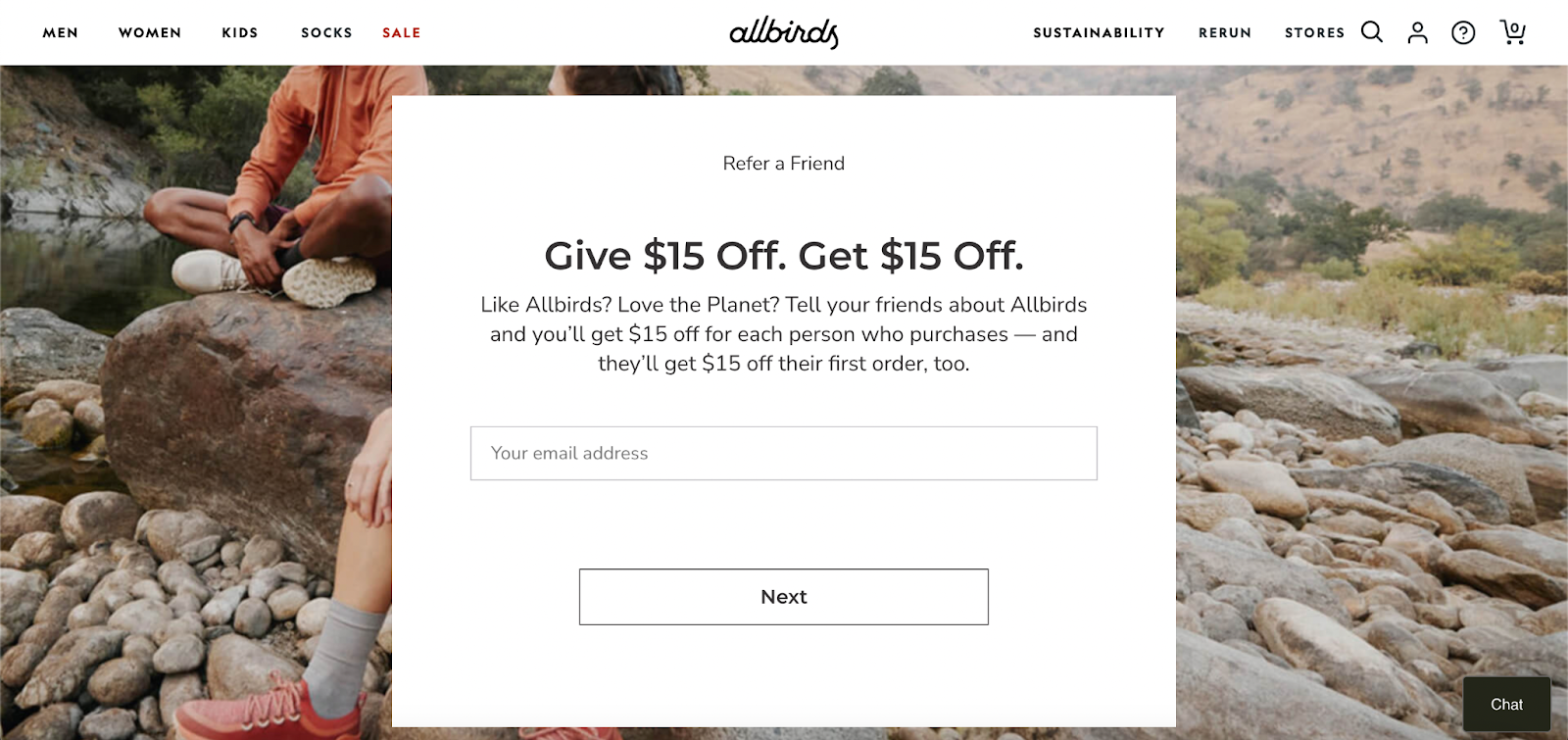
Allbird’s referral landing page demonstrates how simplicity and brand alignment create an effective program. The background image features individuals hiking in the brand’s sustainable shoes, highlighting utility and eco-friendliness. With an on-brand color scheme and ample white space, the layout ensures readability and clear content hierarchy.
The referral program offers a $15 discount for both referrer and referee upon successful referral, emphasizing the brand’s values and benefits. This page sets a stellar example for driving ecommerce referrals.
Moo
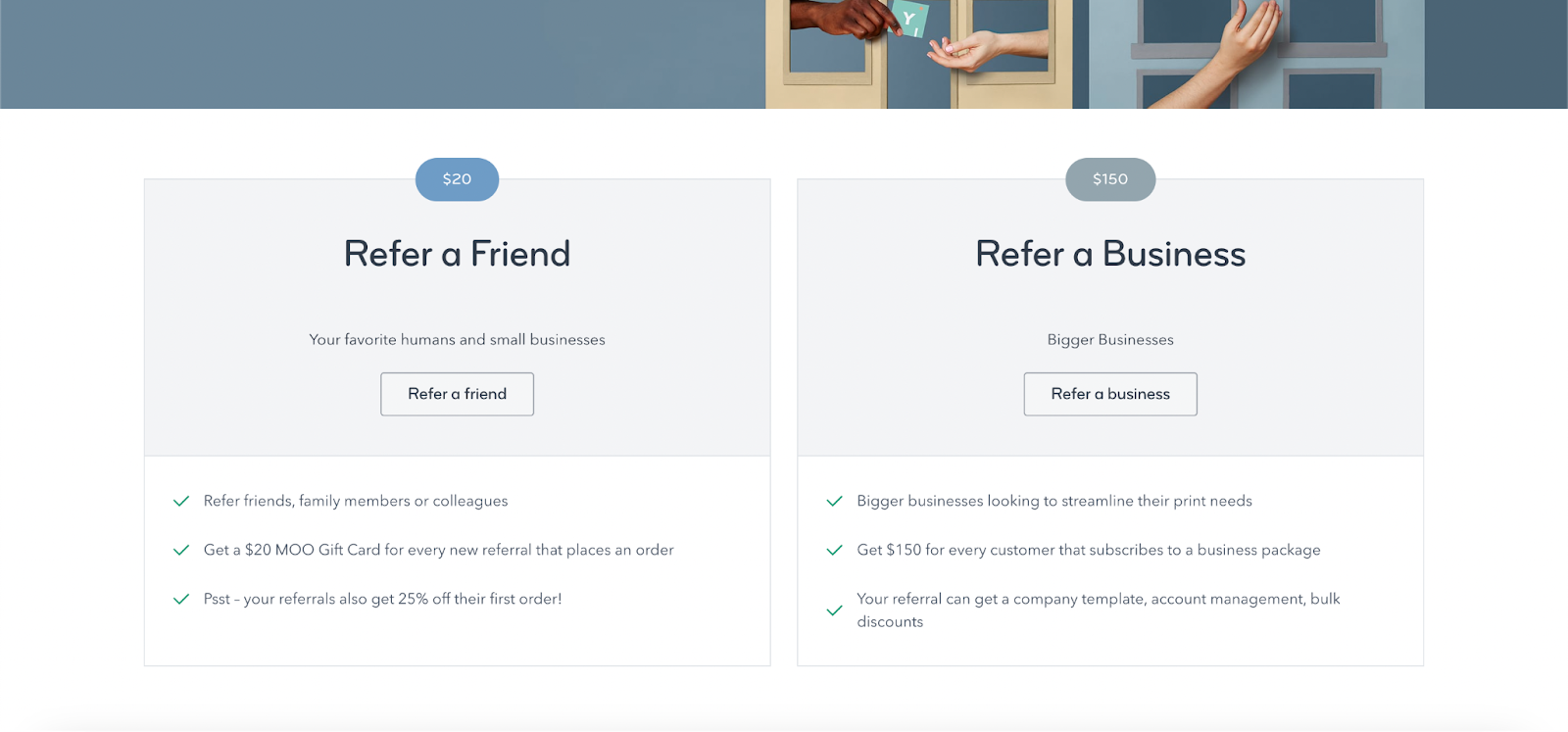
Moo’s referral landing page exemplifies a user-friendly interface accommodating diverse customer needs. It prominently features two referral programs tailored for friends and businesses, streamlining navigation and ensuring relevance for users.
The tiered referral program, catering separately to individuals and businesses, showcased on Moo’s landing page, serves as a model for effective referral strategies. Its intuitive design and transparent presentation of benefits simplify user engagement and facilitate brand promotion to their networks.
Skin O2

Skin O2, a renowned beauty and skincare brand based in Australia, gained prominence for its vegan, cruelty-free, and non-acnegenic products. Established by a prominent cosmetic surgeon, the brand transitioned into clean beauty and garnered recognition in media outlets such as Cosmopolitan, Elle, ENews, and NBC. Despite its acclaim, Skin O2 offers fairly priced products, ranging from $20 to $200.
They also employ organic referrals as a strategy for ongoing audience expansion:
- Offer a $30 discount to a friend making their initial purchase. Upon their purchase, you’ll receive a $30 discount code as well.
- Provide a clear and concise explanation of the referral program to avoid any confusion.
- Display a pop-up on the lower left corner of the screen promoting other rewards programs offered by the brand.
Who Gives A Crap
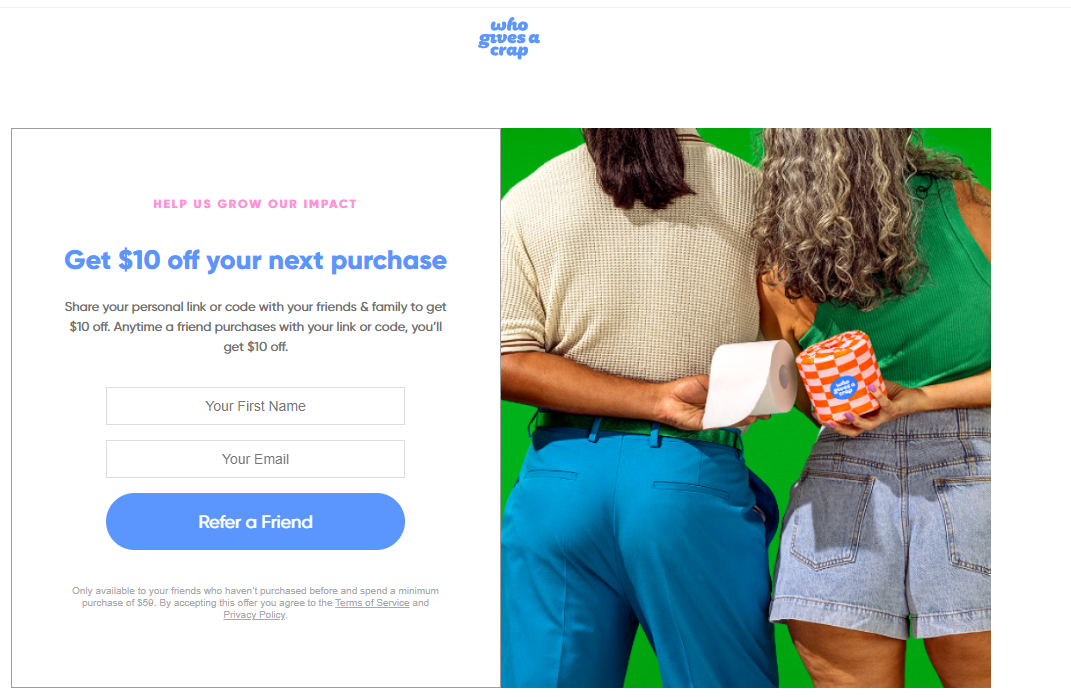
Who Gives A Crap boasts a robust customer referral initiative. Originating from a crowdfunding campaign in 2012, it stands out as one of my preferred companies. Their core product? Tissue paper. Their mission? Allocating 50% of their profits to initiatives aiding the 2.4 billion individuals lacking access to toilets or adequate sanitation. With rolls of their exceptionally soft toilet paper priced between $1 and $2, their commitment is commendable considering their cause.
It’s undoubtedly a brand worth recommending to others, and its referral program effectively reinforces that:
- Provide $10 and receive $10 for each successful purchase referral.
- Incorporate an image showcasing children who benefit from every purchase, evoking a different emotional response compared to merely showcasing the product.
- Explicitly mention the brand’s values in the referral pitch, highlighting what they stand for.
Kettle & Fire
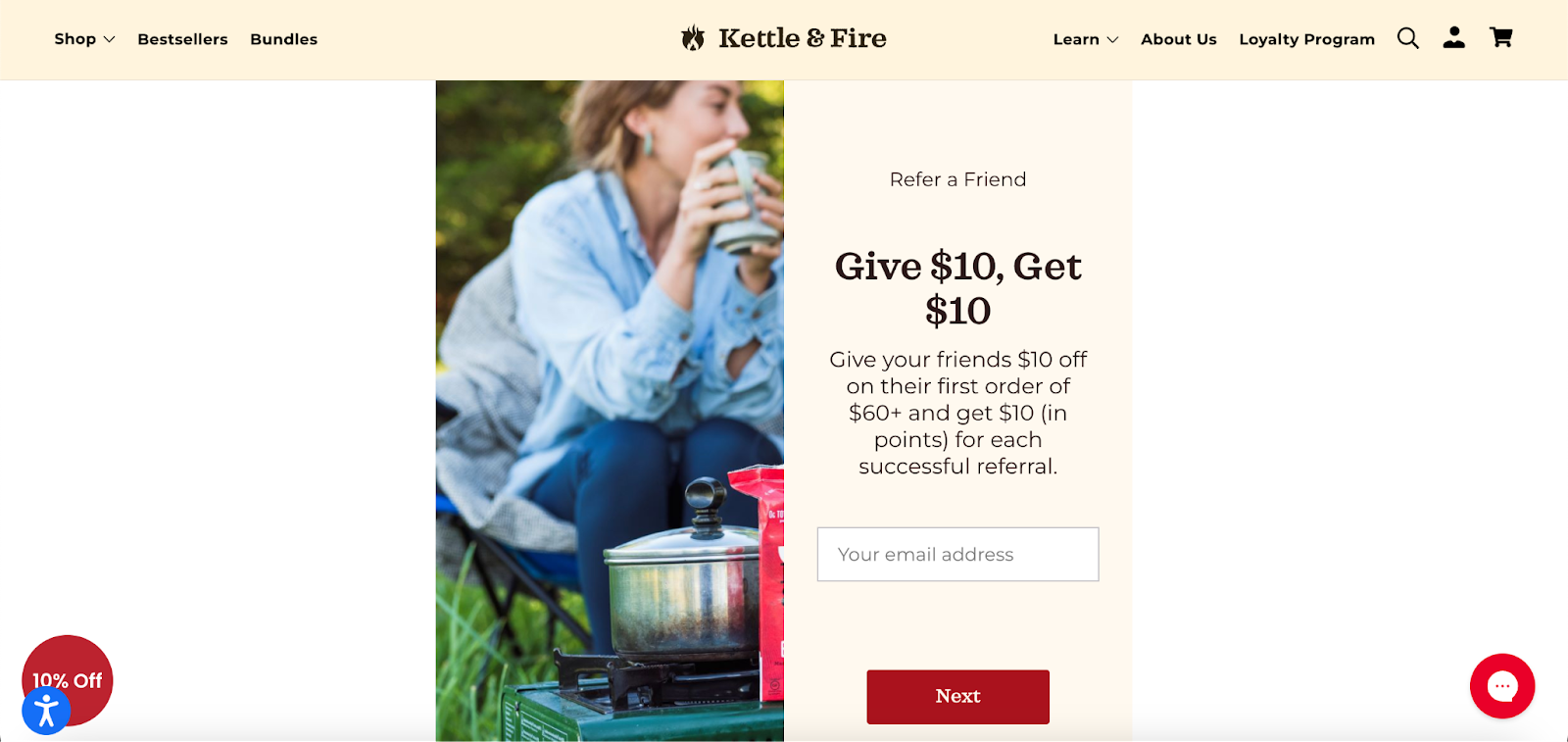
Kettle & Fire’s referral program stands out for its equitable benefits, offering $10 off for both referrers and referees. This incentive is prominently displayed on the clean and straightforward landing page, which emphasizes program benefits with minimal text. The clear call-to-action button ensures ease of participation, making it simple for users to engage and enjoy rewards. Overall, Kettle & Fire sets a great example for effective referral marketing in ecommerce.
Great Jones
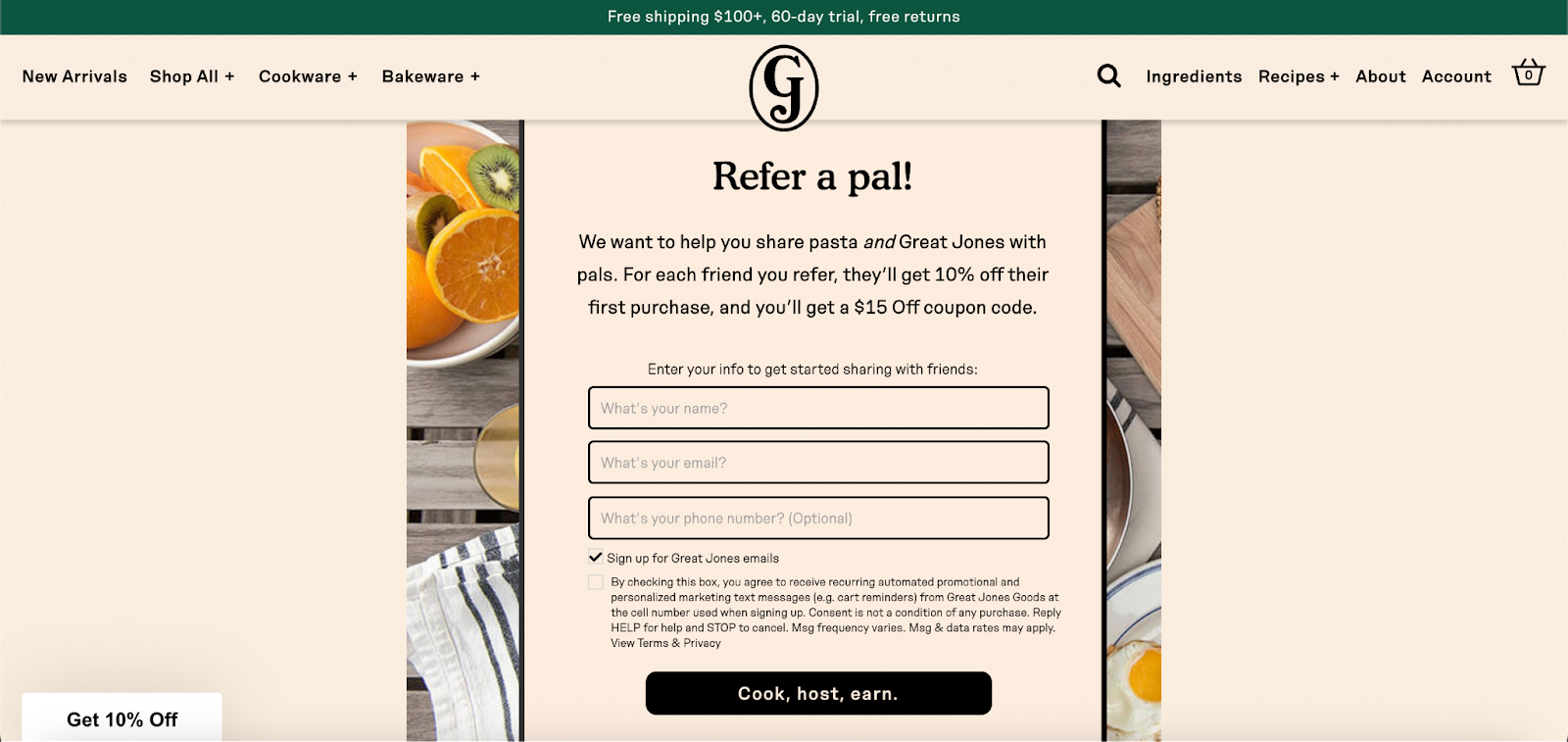
Great Jones’ referral landing page boasts an attractive design accentuated by a food-centric background, effectively conveying the purpose of their cookware. The referral program provides a 10% discount for referees and a $15 off coupon for referrers.
Personalized language like “pals” instead of “friends” and a unique CTA phrase “cook, host, earn” inject a playful and engaging element into the page. With its user-friendly navigation and clear call to action, Great Jones’ referral program exemplifies effective referral marketing in the ecommerce sphere.
Frank & Oak
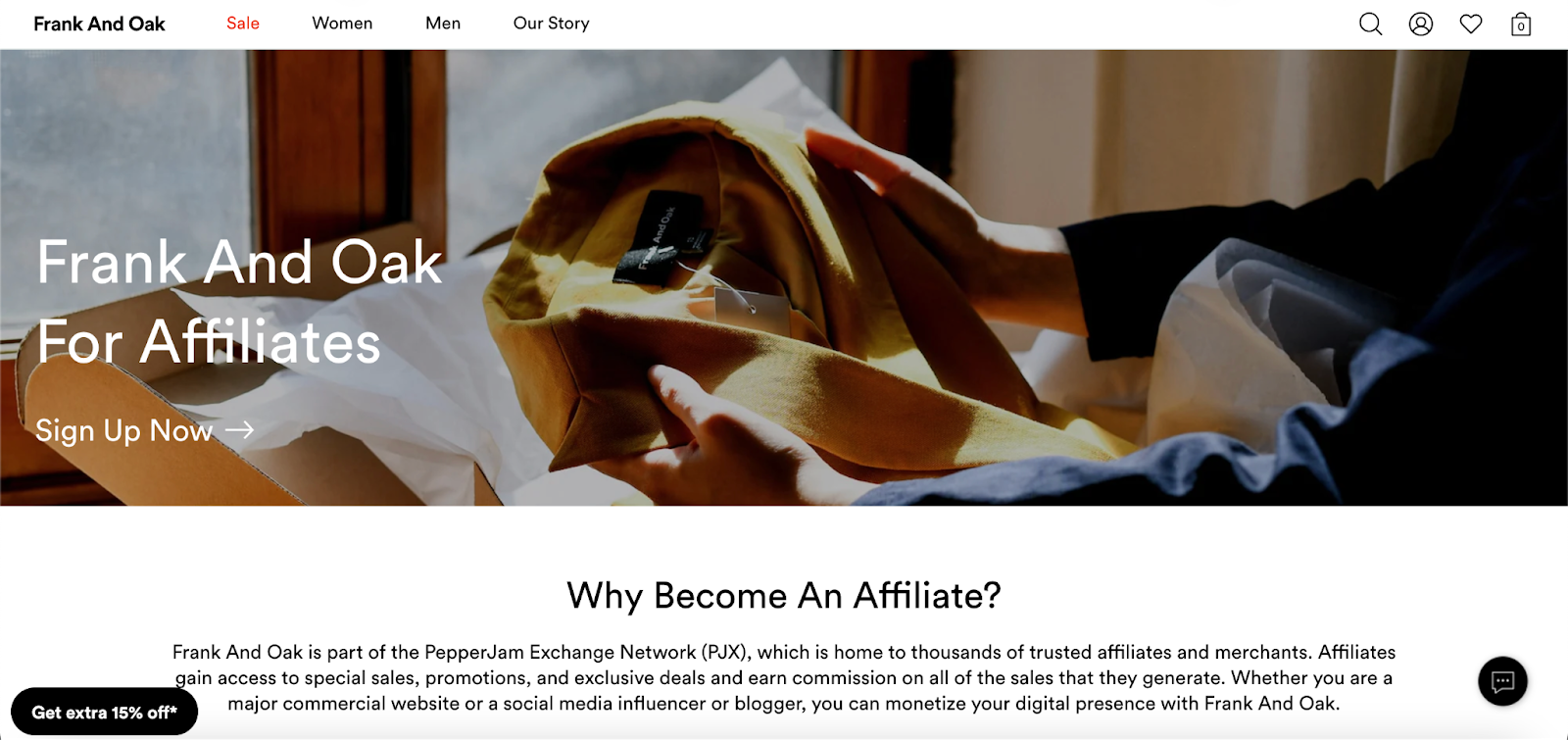
Frank & Oak, a menswear store renowned for its ethically-sourced and sustainable solutions, blends classic styles with contemporary cuts to deliver captivating clothing options.
Instead of traditional commission payouts for referral purchases, Frank & Oak has established a robust affiliate partnership program. Through this program, affiliates have the opportunity to earn income by providing their audiences with exclusive promotions and sales offers, receiving a 5% commission on all purchases made through their referrals.
Leesa
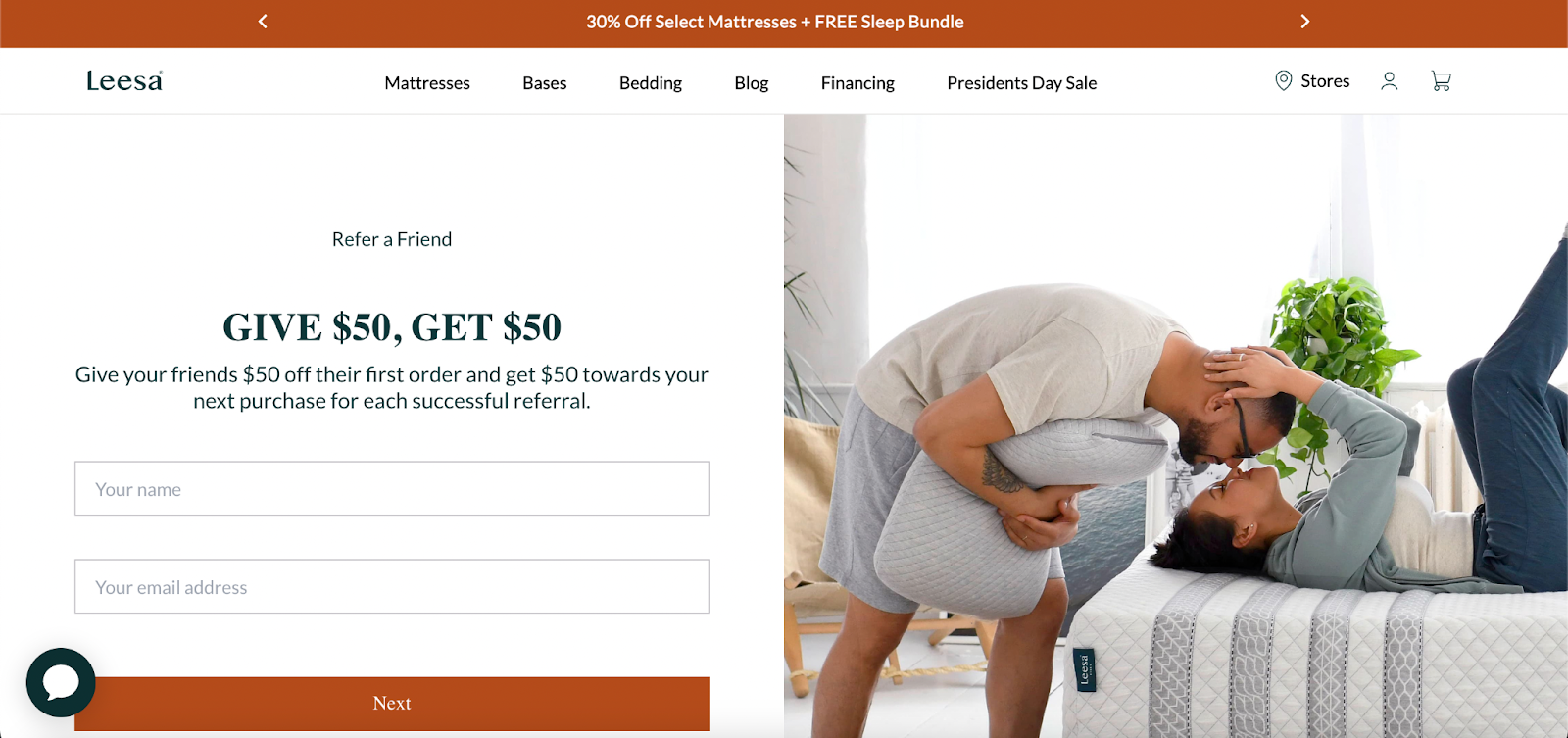
Leesa is dedicated to improving the lives of those in need through various impactful initiatives. For every 10 custom-made mattresses sold, they donate one to non-profit organizations aiding homeless and at-risk individuals.
Additionally, Leesa collaborates with the Arbor Day Foundation to plant a tree for each mattress sold and actively supports local community-focused organizations through volunteerism and resources.
Their refer-a-friend program mirrors this generosity. Referrers provide a $50 discount to friends for their initial purchase, while Leesa rewards the referrer with a $50 discount for their subsequent purchase.
Conclusion
That’s a wrap! Designing and running a successful referral program is hard work but with the right understanding and approach, it becomes a seamless process.
Just ensure that you follow the steps listed in this article by choosing an incentive that you can keep up with in the long run and that doesn’t shift the focus of the customer from promoting a business they like to simply getting a reward.
Also, making referral requests at the right time and tracking the progress of the program is vital.
And as we’ve already seen you don’t have to go through this process from scratch you can take advantage of referral tools that incorporate all the steps needed into a single app and help you automate the process.
FAQs
1. What is a referral program, and why is it important for e-commerce businesses?
A referral program is a marketing strategy where existing customers refer new customers to a business in exchange for rewards or incentives. It’s important for e-commerce businesses because it leverages the power of word-of-mouth marketing, helps acquire new customers cost-effectively, and fosters loyalty among existing customers.
2. Can I automate the management of my referral program?
Yes, you can use referral marketing software or platforms to automate the management of your referral program. These tools help track referrals, manage rewards, and analyze program performance, saving you time and effort.
3. What are some best practices for running a successful referral program?
Some best practices include:
- Make it easy for customers to participate and share referrals.
- Offer attractive incentives that provide value to both referrers and referees.
- Provide clear instructions and guidelines for participating in the program.
- Regularly communicate and promote the referral program to your customer base.
- Continuously monitor and optimize the program based on performance data and customer
4. What are some common incentives I can offer in my referral program?
Common incentives include:
- Discounts or coupons for both the referrer and the referee.
- Free products or samples.
- Store credit or loyalty points.
- Exclusive access to promotions or events.


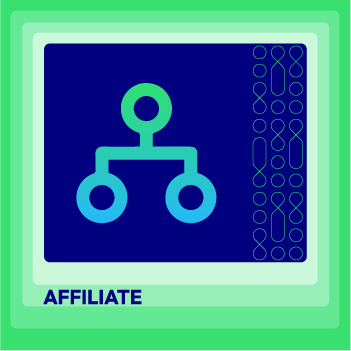



![Top 20+ Must-have Shopify Apps for 2025 [Free & Paid] - Mageplaza](https://cdn2.mageplaza.com/media/blog/must-have-shopify-apps/top-must-have-shopify-apps.png)
![[2025 Updates] Top 10+ Upsell Apps for Shopify - Mageplaza](https://cdn2.mageplaza.com/media/blog/best-upsell-shopify-app/cover.png)